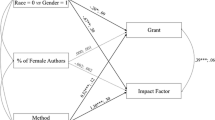Abstract
The harsh and saddening reality of gender equality cripples the ideology behind human rights. The “modern” world, although moving ahead, is still far behind in providing equal standards to men and women, favouring the former. The paper explains the various types of gender inequalities in detail, broadly classifying them as: academics, economics, social and pandemic. The academic gender inequality highlights the alarming differences in literacy rate of males and females from the year 1901 to 2011 and its impact on the lives of women. Further, it is seen that dropout rates are higher in the case of females as compared to males. Thus, females are often underrepresented in science, technology, engineering and mathematics (STEM) fields. The paper also looks into the contribution of female authors vs. male authors in research areas. The category of the economics of gender inequality discusses the economic factors affecting equality. Inequality at the workforce, its causes and its impacts on the financial independence of women are discussed in the paper, highlighting the effect of women empowerment on GDP. The social factors of gender equality discuss the physical and mental health of women and the violence faced by them in the patriarchal society. In the situation of a pandemic, a rise in gender inequality is seen. The paper discusses the reasons behind this using three scenarios: Ebola virus pandemic of 2014–2016, Zika virus pandemic and the current coronavirus pandemic. Several measures that have been opted to reduce the gender gap are also discussed in the paper.
Access this chapter
Tax calculation will be finalised at checkout
Purchases are for personal use only
Similar content being viewed by others
References
P. Jha, and N. Nagar. 2015. A study of gender inequality in India. The International Journal of Indian Psychology. [Online]. Available: https://www.academia.edu/download/55230786/1170-1428777528.pdf.
Lawrence, W., et al. 2009. Why women of lower educational attainment struggle to make healthier food choices: the importance of psychological and social factors. Psychology & Health 24 (9): 1003–1020.
G. Mhrd. 2016. Educational statistics at a glance. New Delhi: Government of India
S. Nair. 2012. National assessment of the participation of women and girls in the national STI system based on the gender equality-knowledge society framework …. Women in global science and technology (wisat)
Gupta, N. 2012. Women undergraduates in engineering education in India: a study of growing participation. Gender, Technology and Development 16 (2): 153–176.
Dutta, D. 2017. Cultural barriers and familial resources for negotiation of engineering careers among young women: relational dialectics theory in an Asian perspective. Journal of Family Communication 17 (4): 338–355.
Varma, R. 2009. Exposure, training, and environment: women’s participation in computing education in the United States and India. Journal of Women and Minorities in Science and Engineering 15: 205–222.
S. Nair. 2015. More gender inequality in India than Pakistan, Bangladesh: UN. Indian Express. December, vol. 15.
S. Sumanjeet. The State of gender inequality in India. Gender Studies 15(1): 139–157.
S. Malhotra. 2015. India in the world economic forum global gender gap report 2015. Business Today, November.
Ilo. (2014). Global employment trends 2014: Risk of a jobless recovery? International Labour Organization.
R. Gandhi. 2015. Women in business: can P2P lending bridge gender gap in access to capital. The Times of India. June, vol. 19.
K. Schwab, R. Samans, and S. Zahidi. 2015. The global gender gap report 2015.
K. Menon-Sen, and A. K. S. Kumar. 2001. Women in India: how free? How equal?. [Online]. Available: http://www.clusterobservatory.in/articles/Article%20No.%2035.pdf.
S. Pulugurtha. 2008. How a lack of education adversely affects girls. Empowerment International, vol. 1.
Davies, S.E., and B. Bennett. 2016. A gendered human rights analysis of Ebola and Zika: locating gender in global health emergencies. International Affairs 92 (5): 1041–1060.
Harman, S. 2016. Ebola, gender and conspicuously invisible women in global health governance. Third World Q 37 (3): 524–541.
L. Sochas, A. A. Channon, and S. Nam. Counting indirect crisis-related deaths in the context of a low-resilience health system: the case of maternal and neonatal health during the Ebola epidemic in Sierra Leone. Health Policy Plan. 32(suppl_3): iii32–iii39.
Wenham, C., et al. 2019. Zika, abortion and health emergencies: a review of contemporary debates. Global Health 15 (1): 49.
C. Wenham, J. Nunes, G.C. Matta, C. de Oliveira Nogueira, P.A. Valente, and D.N. Pimenta. 2020. Gender mainstreaming as a pathway for sustainable arbovirus control in Latin America. PLoS Negl. Trop. Dis., vol. 14, no. 2, pp. e0007954, Feb 2020. Accessed 20 Nov 2020. [Online].
Author information
Authors and Affiliations
Editor information
Editors and Affiliations
Rights and permissions
Copyright information
© 2022 The Author(s), under exclusive license to Springer Nature Singapore Pte Ltd.
About this paper
Cite this paper
Mudgal, S., Mahajan, V., Chowdhury, A. (2022). Gender Inequality: Academic, Economic, Social and Pandemic Viewpoint. In: Mahajan, V., Chowdhury, A., Kaushal, U., Jariwala, N., Bong, S.A. (eds) Gender Equity: Challenges and Opportunities. Springer, Singapore. https://doi.org/10.1007/978-981-19-0460-8_47
Download citation
DOI: https://doi.org/10.1007/978-981-19-0460-8_47
Published:
Publisher Name: Springer, Singapore
Print ISBN: 978-981-19-0459-2
Online ISBN: 978-981-19-0460-8
eBook Packages: Literature, Cultural and Media StudiesLiterature, Cultural and Media Studies (R0)




